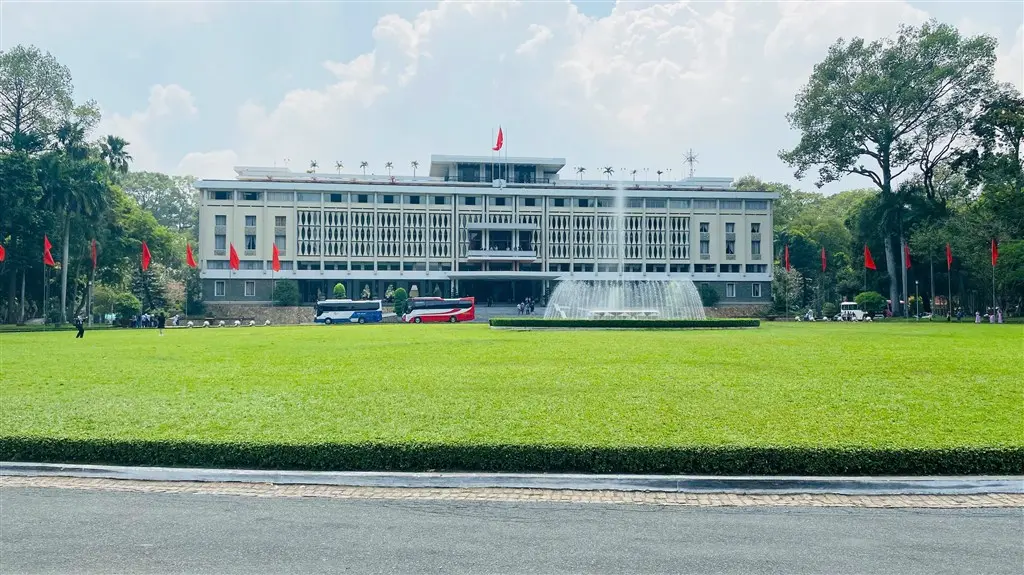At essentialvietnamtravel.com, we delve into Vietnam’s captivating sensory landscape, recognizing that beyond its globally celebrated cuisine lies the equally compelling and diverse world of vietnamese drinks, deeply ingrained in the national identity. These are not mere afterthoughts or simple thirst quenchers; they represent a fundamental aspect of daily life, social interaction, and Food Culture across the nation.
From the potent brew of dark Coffee dripping slowly through a Phin filter to the cooling embrace of freshly brewed Tea, the vibrant sweetness of tropical fruit Smoothie creations, and the unique character of local Bia (beer), Vietnam drinks offer a journey into the heart of Asian Cuisine with a distinctly Vietnamese twist. Understanding these Beverages is crucial to fully appreciating the rhythm and flavor of life in Vietnam.
Ready to Explore Vietnam’s Flavors?
Find the best flight deals and plan your unforgettable culinary journey to Vietnam today!
This com prehensive guide, brought to you by EssentialVietNamtravel.com, serves as your passport to exploring these essential Refreshments. Our goal is to help you Discover types of vietnamese beverages, understand their origins and significance, and confidently Locate vendors offering authentic experiences. We will delve into iconic drinks like Cà phê sữa đá, explore the subtle world of Vietnamese Tea, celebrate the bounty of tropical fruits in Sinh tố and Nước ép, and uncover unique street-side sips.
Prepare to navigate the exciting realm of Thức uống Việt Nam, where tradition meets everyday pleasure, and Freshness is valued above all. These drinks are inseparable from the Vietnamese experience, found everywhere from bustling Ho Chi Minh City sidewalks to serene Hanoi alleys. Let’s begin this flavorful exploration.
Discovering Iconic Vietnam Beverages: From Coffee to Smoothies
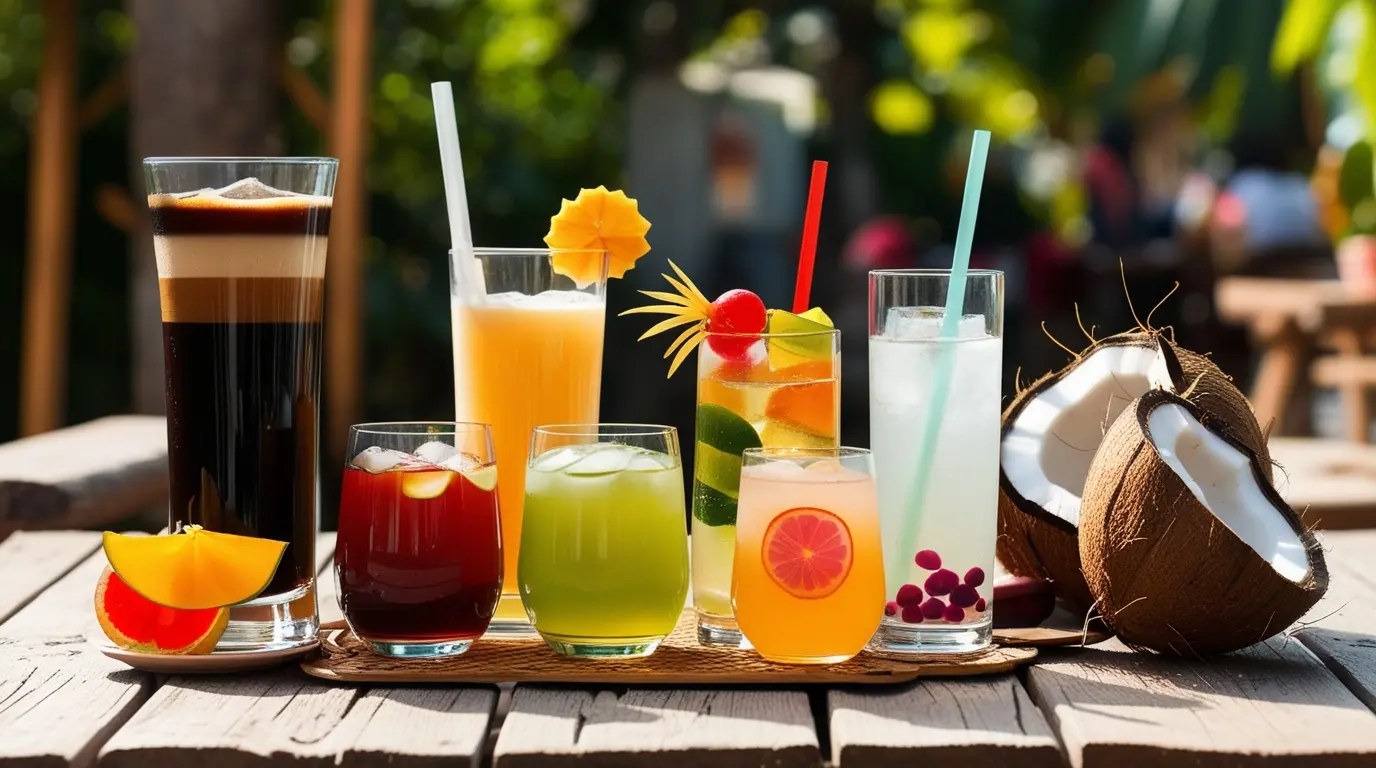
The panorama of vietnamese drinks is remarkably broad, reflecting the country’s elongated geography, diverse ethnic groups, and rich history. These Vietnam beverages are far more than simple liquids; they are liquid culture, performing vital roles in daily routines, social rituals, and even traditional wellness practices.
The range spans from invigorating morning starters like strong Coffee to midday coolers like ubiquitous Tea, celebratory toasts with Bia, healthy Herbal tea infusions drawing on Traditional medicine, and delightful fruit-based Smoothie (Sinh tố) and Juice (Nước ép) concoctions enjoyed anytime. Unlike meals focused on Solid foods, these Refreshments offer different textures and immediate sensory impact.
Exploring this vibrant category reveals several defining characteristics that set Vietnamese refreshments apart. A profound Fresh ingredients focus is paramount. Vietnam’s fertile land yields an abundance of Tropical fruits, aromatic Fresh herbs, and spices, which form the backbone of many drinks. Think fragrant mint, zesty calamansi (Kumquat), sweet Sugarcane, and creamy Avocado. The masterful Balance of flavors is another hallmark.
Vietnamese palates appreciate complexity, often combining sweet, sour, bitter, and aromatic notes in a single glass. The Preparation method is often as important as the Ingredients, influencing the final taste and Texture. Slow-drip Phin coffee brewing, rapid pressing for juices, careful blending for smoothies – each Method determines Texture and flavor intensity. Temperature plays a critical role, with iced variations dominating due to the tropical climate, offering respite from the heat.
Understanding these elements – the emphasis on fresh components, the sophisticated flavor balancing, the specific preparation techniques, and the preference for chilled servings – is key to appreciating Vietnam drink specialties. These are not simply variations of global trends; they are distinct creations deeply rooted in local availability and taste preferences. They offer a unique sensory journey into Southeast Asian drinks culture, providing a delicious counterpoint to the country’s renowned Vietnamese food like Phở and Bánh mì.
They stand in contrast to many Non-Vietnamese beverages or typical Western drinks, often showcasing unexpected ingredient combinations or preparation styles.As EssentialVietNamtravel.com emphasizes, engaging with these Vietnamese beverages is not optional for the curious traveler; it’s an essential part of understanding the soul of Vietnam. The culinary landscape is incomplete without them.
An Introduction to Popular Vietnamese Refreshments
Embarking on your exploration of vietnamese drinks involves familiarizing yourself with some key players and their core Ingredients. The undisputed champion of recognition is Cà phê sữa đá, the iconic iced coffee sweetened with Condensed milk. It’s a potent, sweet, and creamy concoction that defines Vietnamese Coffee culture. Equally ubiquitous, though far simpler, is Trà đá.
This iced green tea is the standard table Beverage in most eateries, incredibly Inexpensive (often free) and perfectly designed for cleansing the palate and cooling down. Its Main Ingredient is typically a straightforward Green tea.
For those who prefer fruit-forward Refreshments, the world of Sinh tố opens up. Sinh tố bơ, the avocado smoothie, is a revelation for many visitors. Its rich, Creamy Texture and surprising sweetness (usually thanks to Condensed milk) make it a decadent treat. Beyond avocado, countless other fruits like mango (xoài), sapodilla (hồng xiêm), and dragon fruit (thanh long) are blended into delicious smoothies.
Nuoc mia, fresh Sugarcane juice, offers pure, unadulterated sweetness, often brightened with a squeeze of Kumquat. It’s pressed fresh before your eyes from a Sugarcane stalk. Another natural hydrator is Coconut water (nước dừa), frequently served chilled directly from a young green coconut.
Beyond these headliners, delve into Traditional Vietnamese herbal drinks. Artichoke Tea (trà atiso), primarily associated with the cooler climate of Da Lat, is enjoyed for its unique taste and purported Health benefits, particularly Artichoke Tea, Benefit, Liver health. Various other infusions using lemongrass, ginger, or chrysanthemum might be found, reflecting local flora and Traditional medicine practices.
A recurring theme you’ll notice is the prominent Use of condensed milk, especially in coffee and smoothies. While partly born from the historical difficulty of preserving fresh milk, its intense sweetness and rich Texture became a preferred Flavor profile component, perfectly complementing the strong Robusta coffee or balancing fruit tartness. A steadfast rule persists: freshness is paramount. Be it coffee meticulously dripped, juice freshly squeezed, or tea brewed continuously, the focus is always on delivering instant, lively flavors, setting Vietnamese drinks apart from numerous pre-packaged Western options.
Ca Phe Sua Da: The Quintessential Vietnamese Coffee Experience
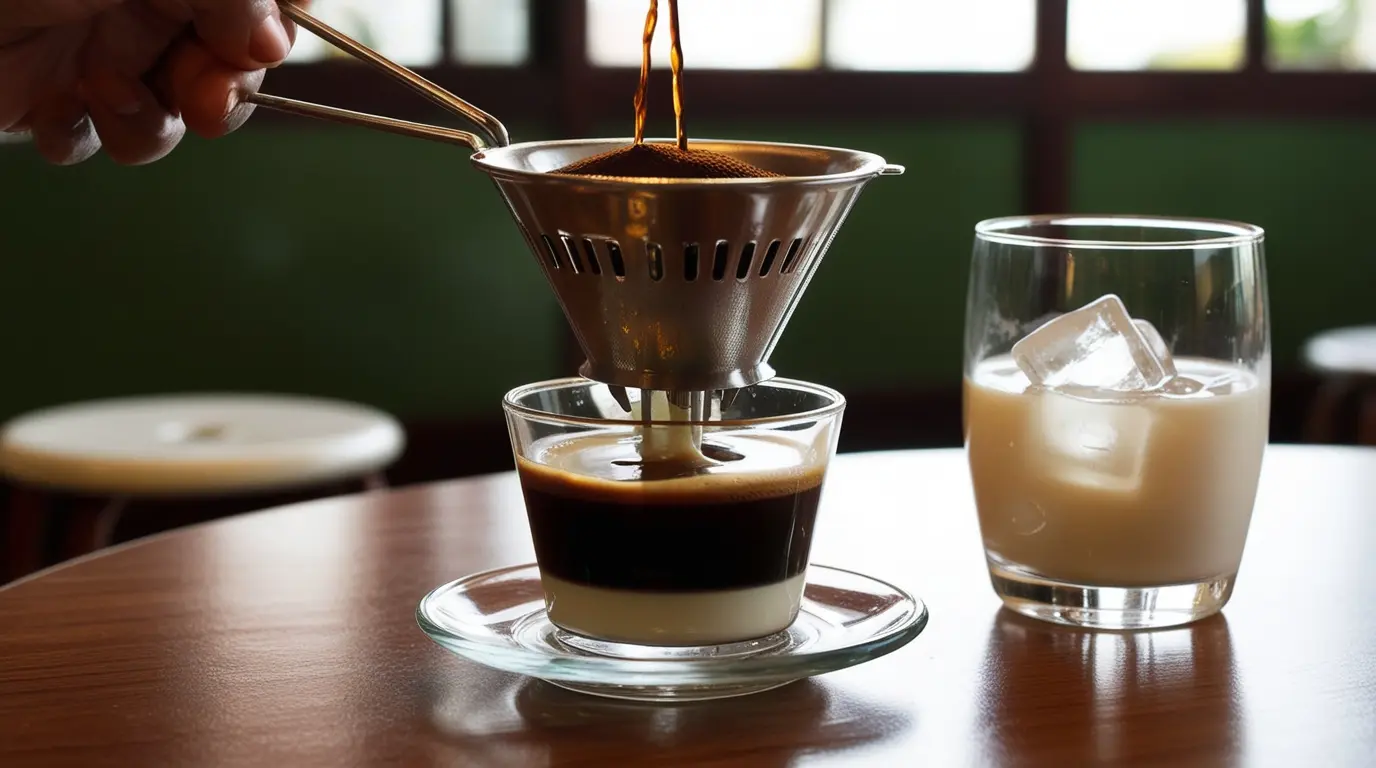
No discussion of vietnamese drinks can truly begin without paying homage to Ca phe sua da. This isn’t just coffee; it’s a cultural institution, a daily ritual, and arguably Vietnam’s most famous liquid export. It embodies the nation’s unique Coffee culture. Its distinct character stems from specific Ingredients and a unique Preparation method. The foundation is almost always Robusta coffee.
Vietnam is the world’s largest producer of Robusta, and its beans define the national coffee taste. Vietnamese coffee is strong – this isn’t hyperbole. Robusta coffee beans contain significantly more caffeine than Arabica varieties and possess a bold, earthy, often nutty or chocolatey Flavor profile, with a characteristic bitterness that requires balancing. This inherent strength is the starting point for ca phe sua da.
The magic happens with the Phin filter. This small, simple, typically aluminum or stainless steel device is central to the process. It consists of a chamber for coffee grounds, a filter screen, and a lid. The Phin filter, Used for, Coffee brewing, sits directly atop the drinking glass. Coarsely ground Robusta is placed inside, hot water is poured over, and then gravity works its slow magic.
The coffee drips deliberately, intensely, into the glass below. This patient Phin coffee brewing extracts a maximum amount of flavor, creating a concentrate far stronger than typical drip coffee. The essential counterpoint to this intensity is the Sweetener: Condensed milk. A generous layer (often several tablespoons) is typically placed in the Iced coffee glass before the coffee starts dripping. As the hot, dark coffee hits the thick, sweet milk, the foundation for the final Drink is type of Beverage is laid.
Once the dripping finishes (a process that can take 5-10 minutes, encouraging conversation and relaxation), the coffee and condensed milk are stirred together vigorously, creating a uniform, deep brown liquid. This potent mixture is then poured over a tall glass packed with ice (“đá”). The Temperature shift is immediate and crucial.
The resulting ca phe sua da is a multi-sensory experience: strong coffee aroma, visual contrast of dark liquid over ice, the clinking sound of the spoon, and the final taste – a harmonious collision of bitter, sweet, creamy, and cold. It’s a signature Vietnam drink specialties experience, enjoyed morning, noon, and night across the country. While the iced version is dominant, hot variations (cà phê sữa nóng) exist. And of course, there’s the famous Egg Coffee (Cà phê trứng), a Hanoi specialty with Origin stories tied to wartime scarcity.
Here, the Main Ingredient list expands to include whisked Egg yolk and sugar, creating an incredibly rich, Frothy, almost tiramisu-like topping over strong coffee. EssentialVietNamtravel.com strongly recommends finding a traditional cafe, pulling up a small stool, and watching the entire Cà phê ritual unfold. While you can Find recipes online, the authentic atmosphere is irreplaceable.
The Role of the Phin Filter and Condensed Milk
The Phin filter is far more than a mere coffee maker; it represents a philosophy, a deliberate slowing down in a fast-paced world. Its simple design forces patience. Watching the dark drops steadily accumulate symbolizes a moment of pause, a contrast to the instant gratification often sought in modern Coffee culture. The Phin filter, Used for, Coffee brewing, facilitates a unique extraction.
The slow contact time between hot water and the coarse Robusta coffee grounds, combined with the metal filter’s properties, yields a brew with exceptional body and intensity. This specific Method determines Texture and concentration, making it fundamentally different from the quicker brews of espresso machines or the lighter body of paper-filtered pour-overs commonly found in Western drinks scenes. The Phin coffee brewing process itself becomes part of the enjoyment, encouraging conversation or quiet contemplation while waiting.
The Use of condensed milk is equally integral and culturally significant. Its widespread adoption in Vietnam has historical roots in the French colonial period and the challenges of sourcing and storing fresh milk in a tropical climate. Condensed milk brands offered a practical, shelf-stable solution. However, its use evolved beyond mere necessity into a distinct culinary preference.
The thick, intensely sweet milk provides the perfect counterpoint to the natural bitterness and strength of Robusta coffee. Sweetness is common in many vietnamese beverages, acting as a foil to sour or bitter elements, and condensed milk achieves this with a unique richness. It doesn’t just sweeten; its high sugar and milk fat content contribute a velvety Creamy Texture and mouthfeel that fresh milk and sugar cannot replicate in the same way. This specific Sweetener choice is a defining characteristic, creating a Flavor profile that is unmistakably Vietnamese and a key differentiator from Non-Vietnamese beverages. The marriage of strong, Phin-brewed Robusta and sweet, thick condensed milk is the heart of ca phe sua da.
Beyond Coffee: Refreshing Tra da and Other Vietnamese Teas
While Vietnamese Coffee often steals the international spotlight, Tea (Trà) holds an arguably deeper and longer Historical significance within Vietnamese Cuisine and culture. It’s a ubiquitous presence, a symbol of hospitality, and a daily staple for millions. The most common manifestation is Trà đá, literally “iced tea.” Walk into almost any restaurant or food stall, from humble street-side eateries serving Phở to more established venues, and you’ll likely find a pitcher of complimentary Trà đá on the table or brought immediately upon seating. Its purpose is simple: hydration and palate cleansing.
The Main Ingredient is usually a basic, inexpensive Green tea, brewed relatively light and served chilled over ice. Trà đá, Temperature, Iced, makes it the perfect antidote to Vietnam’s often humid heat. Its Cost being negligible (Inexpensive or free) makes it the democratic Drink vietnamese enjoyed by everyone, fostering a sense of welcome.
However, the world of Vietnamese Tea extends far beyond the simple Tra da. Vietnam produces a variety of teas, with distinct regional specialties. Lotus tea (Tra sen) is perhaps the most famous artisanal tea. High-quality Green tea leaves are traditionally stored with fresh lotus blossoms overnight, allowing the tea to absorb the delicate, ethereal fragrance. This labor-intensive process results in a highly aromatic brew, often reserved for special occasions or given as a prestigious gift, sometimes carrying Ritualistic association.
Another notable category is Herbal tea, often linked to Traditional medicine and regional flora. Artichoke Tea (Trà atiso) from the Central Highlands city of Da Lat is widely consumed for its distinct, slightly vegetal flavor and believed Health benefits, particularly Artichoke Tea, Benefit, Liver health. Other Traditional Vietnamese herbal drinks might feature ingredients like pandan leaves (la dua) for aroma, ginger (gung) for warmth and digestion, or chrysanthemum flowers (bong cuc) for cooling properties.
These teas highlight the use of Fresh herbs and natural Ingredients. Whether it’s the humble, ever-present Tra da or a more refined Lotus tea, Tea in Vietnam offers a diverse spectrum of Flavor profile experiences and serves as a vital Non-alcoholic Vietnamese beverage, deeply woven into the Cultural and social tapestry.
Tropical Refreshment: The World of Smoothies and Juices
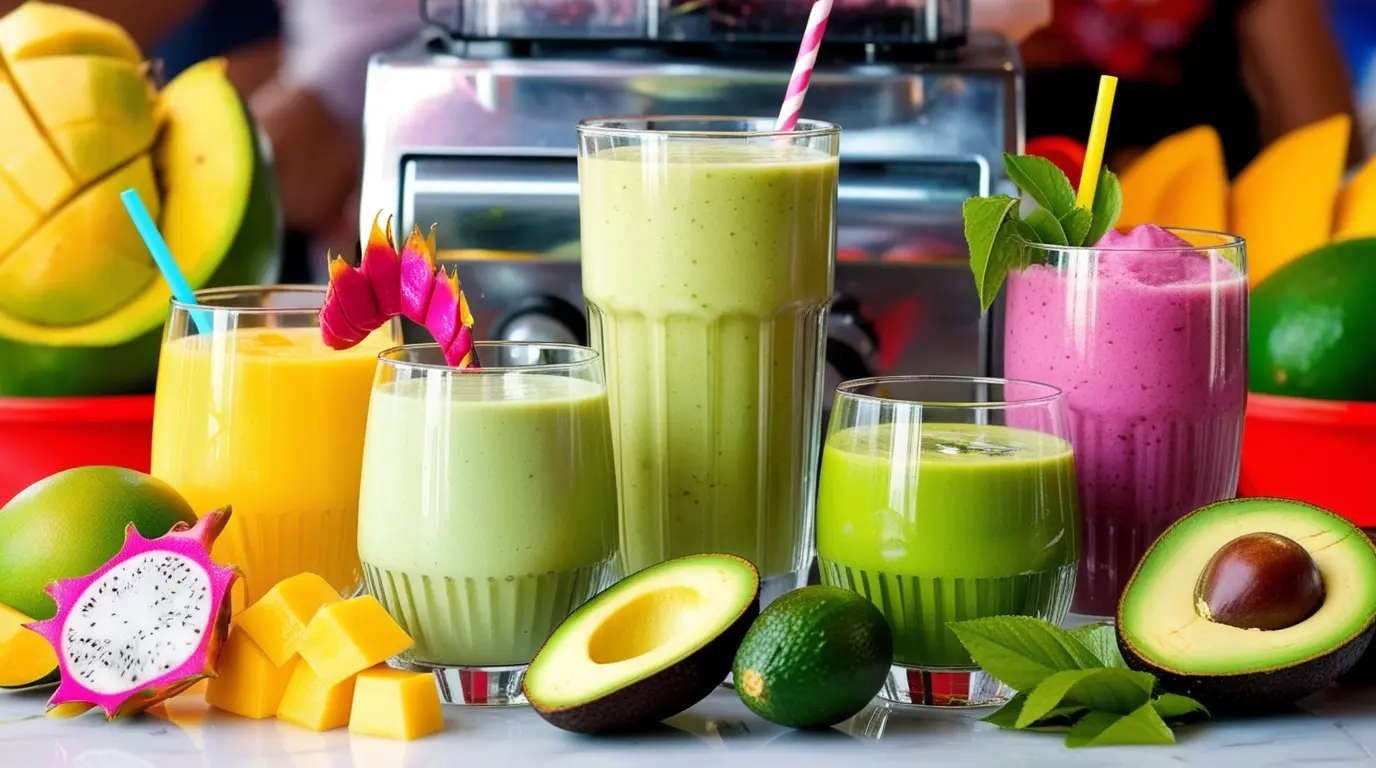
Vietnam’s location in the tropics blesses it with an incredible variety of luscious Tropical fruits, forming the basis for another wildly popular category of vietnamese drinks: Sinh to (fruit smoothies) and Nuoc ep (fresh fruit juices). These vibrant, colorful Non-alcoholic Vietnamese beverages offer a pure taste of the country’s agricultural bounty and provide delicious, healthy Refreshments.
Strolling through bustling markets or down city streets in places like Hanoi or Ho Chi Minh City, you are guaranteed to encounter numerous stalls dedicated to blending and pressing these fruity delights. The principle of Fresh ingredients focus is vividly on display here, with vendors often showcasing pyramids of ripe mangoes, passion fruit, dragon fruit, avocados, and more.
Nuoc ep refers to pure, unadulterated fruit juice, pressed or squeezed to order. Common and beloved choices include orange juice (nuoc cam), pineapple juice nuoc dua / thom), watermelon juice (nuoc ep dua hau), guava juice (nuoc ep oi), and passion fruit juice (nuoc ep chanh day). Another favorite is Coconut water (nuoc dua), often served refreshingly chilled straight from a young green coconut, sometimes with the soft flesh scooped out to eat. Sinh to, on the other hand, takes things a step further.
Here, fresh fruit is blended, usually with crushed ice, and often incorporates a Sweetener like sugar syrup or, very characteristically, Condensed milk. Yogurt (sua chua) or coconut milk (nuoc cot dua) might also be added for extra richness or flavor complexity. This Method determines Texture, resulting in beverages that range from light and icy slushies to incredibly thick, Creamy, and decadent shakes.
The delightful Combination of textures – smooth fruit puree, crunchy ice bits, creamy additions – is a key part of the Sinh to appeal. While you can find single-fruit smoothies, vendors often offer exciting mixes, allowing you to customize your drink. Trying a sinh to or nuoc ep from a street vendor is a quintessential Vietnamese street food drinks experience, offering a direct taste of the local harvest. EssentialVietNamtravel.com highly recommends being adventurous and trying less familiar fruits like sapodilla (hong xiem) or soursop (mang cau).
Spotlight on Sinh To bo (Avocado Smoothie)
Among the diverse array of Sinh to, Sinh to bo holds a special place. It perfectly exemplifies the creative use of Ingredients and the defining role of Condensed milk in vietnamese drinks. For many visitors accustomed to avocado in savory contexts like salads or guacamole (Solid foods focus in Western drinks culture), encountering it as the star of a sweet, rich Smoothie can be surprising, yet it’s incredibly popular throughout Vietnam. Its allure lies in its luxurious, velvety Texture and satisfying richness, making it feel like a healthy indulgence.
Crafting the Best sinh to bo recipe at home is achievable, capturing the essence of this unique Beverage. Here’s a typical approach for one serving:
- Gather Ingredients: You’ll need the flesh of one large, ripe Avocado (Main Ingredient). Ensure it’s soft to the touch for optimal creaminess. Also gather 2-4 tablespoons of Condensed milk (Sweetener – adjust based on your preference for sweetness and the avocado’s natural flavor), approximately 1 cup of crushed ice (or small ice cubes), and optionally, 2-3 tablespoons of coconut milk or fresh milk for enhanced Creamy texture.
- Prepare the Avocado: Cut the avocado in half lengthwise, twist to separate, and remove the pit. Scoop the green flesh directly into your blender jar, discarding the skin.
- Combine and Blend: Add the condensed milk, ice, and optional coconut/fresh milk to the blender with the avocado flesh.
- Process Until Smooth: Secure the lid and blend on high speed. Continue until the mixture is completely smooth, uniformly pale green, and thick. There should be no large chunks of avocado or ice remaining. If the mixture is too thick to blend properly, add a small splash of water, milk, or coconut milk and blend again.
- Taste and Adjust: Briefly stop blending and taste. Add more condensed milk if you desire more sweetness, or a little more ice if you prefer it thicker and colder. Blend again briefly to incorporate any adjustments.
- Serve Immediately: Pour the Sinh tố bơ into a tall glass. Enjoy this unique Vietnam drink specialties right away for the best Texture and Temperature.
The result is a decadent yet refreshing Smoothie. The avocado contributes healthy fats and unparalleled smoothness, while the Condensed milk provides that signature Vietnamese sweetness and richness. It’s a must-try Flavor profile that perfectly showcases Vietnamese culinary ingenuity.
Excited to try these drinks in Vietnam? Let us help you find the best travel options!
Unique Street-Side Sips: Nuoc mia and Bia Hoi Adventures
The vibrant Street food culture is the lifeblood of Vietnamese Cuisine, and this extends enthusiastically to its vietnamese drinks. Two iconic street-side staples offer unique flavors and experiences deeply embedded in daily life: Nước mía (sugarcane juice) and Bia Hoi (fresh beer). These Vietnamese street food drinks are often enjoyed curbside, perched on the small plastic stools that are synonymous with casual Vietnamese dining. A major part of their appeal lies in the fact that Drinks are affordable, making these simple pleasures accessible to virtually everyone.
Nuoc mia offers pure, unadulterated refreshment extracted directly from Sugarcane. Its Main Ingredient is simply mature stalks of Sugarcane. Vendors, easily recognizable by their specialized pressing machines (often electric, sometimes manual) and prominent displays of greenish-purple Sugarcane stalk bundles, feed the tough stalks into rollers.
The Preparation is mesmerizing to watch: the machine efficiently crushes the fibrous stalks, extracting the sweet, pale green juice. Crucially, most vendors add a small Kumquat or sometimes a slice of lime (Added Flavor) into the press along with the sugarcane. This tiny citrus fruit imparts a vital tartness, cutting through the intense natural sweetness of the sugarcane juice and creating a more balanced and refreshing Flavor profile. Served immediately over a generous amount of ice, Nuoc mia is an instant energy booster and thirst quencher, delivering a raw, grassy sweetness unique among Vietnam beverages.
Bia Hoi, translating roughly to “fresh beer” or “gas beer,” represents a fascinating and highly localized aspect of Vietnamese drinking culture, especially prevalent in Hanoi and northern Vietnam. It’s a specific Type of light, Draught beer characterized by its extreme freshness. Unlike bottled or canned Bia, Bia Hoi is typically unpasteurized, giving it a very Short Shelf life – often brewed early in the morning and intended for consumption the same day.
This rapid turnover ensures a light, crisp taste. Another defining feature is its Low Alcohol Content, usually hovering around a modest 3-4%. Its Fermentation type is quick and simple.
The result is a highly sessionable beer, perfect for sipping on warm afternoons. But Bia Hoi is more than just a Beverage; it’s a deeply Social ritual. In the late afternoon, local “quán bia hơi” (Bia Hoi pubs), often simple open-air establishments, come alive with groups of friends and colleagues gathering to share rounds of this cheap, refreshing beer, usually accompanied by inexpensive snacks like peanuts or fried tofu. Experiencing Bia Hoi offers an authentic slice of local life, showcasing the Economic accessibility and communal spirit embedded in Vietnamese Food Culture.
The Cultural Place of Vietnamese Drinks
In Vietnam, Thức uống Việt Nam (Vietnamese drinks) transcend their basic function of hydration; they are deeply interwoven with the Cultural, Social, and even Economic tapestry of the nation. The act of consuming Beverages is frequently a communal affair, a catalyst for connection and interaction. Coffee shops, from traditional sidewalk spots to modern cafes, serve as vital hubs for meeting friends, discussing business, enjoying solitude while people-watching, or engaging in the national pastime of conversation.
The specific Coffee culture surrounding ca phe sua da, with its slow Phin coffee brewing ritual, inherently encourages lingering and socializing. Similarly, the tradition of gathering for Bia Hoi after a day’s work provides a space for camaraderie and relaxation, primarily, though not exclusively, among men.
Tea, particularly Trà đá, plays a fundamental role as an Integral part of meals. It’s the default accompaniment to countless dishes within Vietnamese Cuisine, served almost automatically alongside bowls of Phở or plates of cơm tấm (broken rice). Its mild flavor cleanses the palate between bites of complex Vietnamese food, enhancing the dining experience. Beyond daily meals, specific drinks often mark particular times or events (Occasion suggests Drink choice).
A fragrant Lotus tea might be served to welcome honored guests, while certain Traditional Vietnamese herbal drinks are consumed specifically for their perceived Health benefits, connecting modern habits to age-old beliefs rooted in Traditional medicine. The Medicinal properties attributed to drinks like Artichoke Tea (Liver health) reflect this connection.
Furthermore, the production, sale, and consumption of vietnamese drinks have significant Economic implications. Countless small-scale farmers cultivate Coffee beans, Tea leaves, Sugarcane, and Tropical fruits. Thousands of street vendors, cafe owners, and brewery workers rely on this industry for their livelihoods. The affordability assumption (Drinks are affordable) makes these beverages accessible across socio-economic levels, contributing to their widespread integration into daily life.
From the Historical significance of formal tea ceremonies in centuries past to the modern buzz surrounding specialty coffee shops and craft Bia, vietnamese beverages reflect the nation’s agricultural heritage, its social dynamics, its adaptation to climate, and its evolving tastes. Understanding this rich Cultural context, recognizing the Logical relationships between Ingredients and Flavor profile, or how Region influences Specialty, elevates the act of drinking from mere consumption to cultural participation. It helps one truly Understand culture.
Where to Find Authentic Vietnamese Drink Experiences
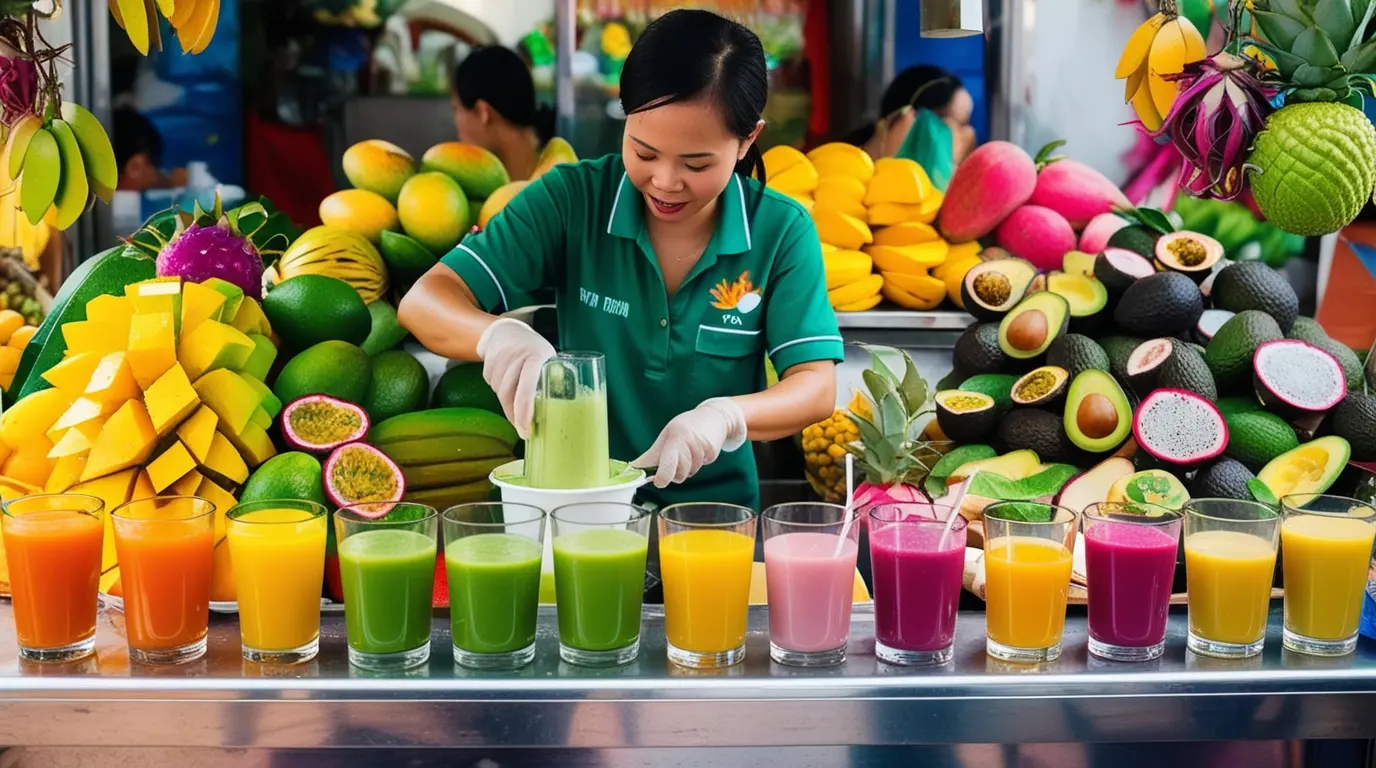
Successfully navigating the world of vietnamese drinks and finding the most authentic experiences is relatively straightforward in Vietnam, but a little guidance can enhance your journey. EssentialVietNamtravel.com suggests seeking out places frequented by locals for the best quality and atmosphere. To Find recipes is easy online, but the real experience lies in the place itself.
For the quintessential Ca phe sua, bypass generic hotel cafes and seek out dedicated local coffee shops. These range from generations-old establishments with timeworn furniture in the alleys of Hanoi’s Old Quarter to bustling sidewalk cafes in Ho Chi Minh City where patrons sit on low stools watching the world go by. Look for the presence of the iconic Phin filter – its active use is a good sign. Don’t be afraid to try smaller, less flashy places; they often harbor the best brews. Asking hotel staff or friendly locals for their favorite “quán cà phê” can lead to hidden gems.
Tra da is the easiest to find; it will appear on your table at almost any establishment serving local Vietnamese food. For more specialized teas like Lotus tea or Artichoke Tea, you might need to visit dedicated tea houses, markets (especially in Da Lat for artichoke products), or specialty food stores. Smoothies and Juices vendors are ubiquitous, especially in markets and areas with high foot traffic. View images online if unsure what a typical stall looks like. Choose vendors with a good display of fresh Tropical fruits and visible blending/pressing operations. Hygiene is important; observe if the vendor uses clean equipment and handles ingredients properly (Trustworthy factor).
Nuoc mia stalls are easily identified by the distinctive sugarcane press and the pile of Sugarcane stalk remnants. Look for them near markets, schools, or busy intersections. They offer instant refreshment. Bia Hoi requires seeking out specific “quan bia hoi.” These are often very basic, open-fronted establishments, sometimes just a collection of plastic tables and stools on a sidewalk, easily recognizable by the prominent “BIA HƠI” signs.
They are busiest in the late afternoon and early evening. Remember that Region influences Specialty – while Ca phe sua da is national, Egg Coffee is strongly associated with Hanoi, and Artichoke Tea with Da Lat. To truly Locate vendors offering authentic tastes and experiences, venture slightly beyond the main tourist thoroughfares. Observe where local crowds gather – it’s usually the best indicator of quality and value. Embrace the Street food culture; trying Vietnamese street food drinks is not just affordable, it’s often the most direct way to connect with the true flavors and spirit of Vietnam beverages.
Plan Your Culinary Trip to Vietnam!
Don’t just read about it, experience it! Find affordable flights and accommodation to start your Vietnamese drink tour.

